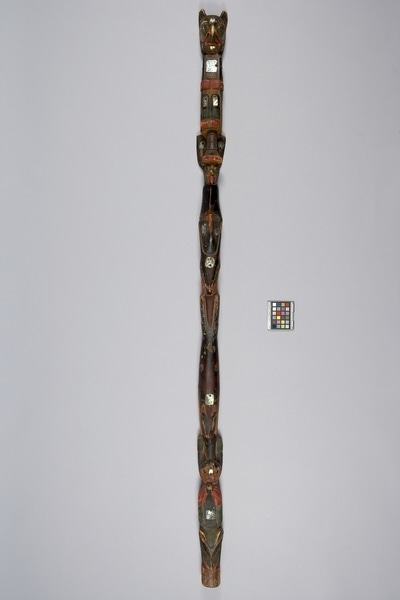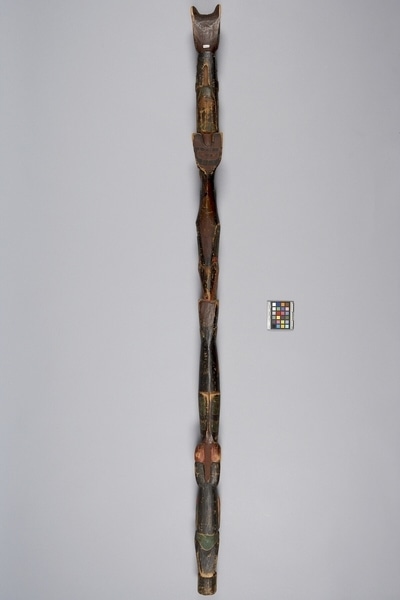Speaker's Staff Item Number: A8140 from the MOA: University of British Columbia




Description
Carved, wooden speaker's staff, or talking stick, with six figures in colours of black, red, green and brown. Abalone shell pieces are inlaid on all of the figures. Top figure is a supernatural eagle, or Kolus, in human-like form, with a crooked beak and a labret. Below that is a human wearing a three-ringed hat. His body morphs into a whale, whose mouth touches the back fins of a sea lion. The bottom bear figure is mounted on top of a short, cylindrical base.
History Of Use
Speaker’s staff (yaḵ̓a̱nt̓p̓eḵ) is brought out at start of a potlatch – a visual reminder of the history of that family. They work their way down to the base figure, the most important figure. It’s said, the paternal ancestor who's holding up the rest of your ancestry. A family’s stick includes history of ownership or claims to special significant places, and some of talk about resources. Birthright and inheritance governed the whole system.
Narrative
According to Peter Macnair's research (see Objects and Expressions, pg. 61), this talking stick was originally presented by Heiltsuk relatives to a Walas Kwagu'l chief, of the Lakwilayla tribe, Hemasak'a (also known as Wakyadzi), who is shown holding the stick in a photograph, in 1912. As his maternal great grandfather, he willed it to Willie Hunt at his birth. According to Mungo Martin (1962), the staff was passed on to a man named Billy McDuff, maternal uncle of Willie Hunt, who passed it on to Willie Hunt when he was older. Macnair believes Willie Hunt sold it to W. Helmer, who later sold it to E. Bevan-Cross, whose collection was purchased by the Museum in 1962. The staff is published in a Curtis photograph from 1912, held by the "...principal chief of the Qagyuhl" (See 'The North American Indian', Volume 10, The Kwakiutl, 1915. Portfolio plate no. 333.) Displayed at a Hunt family potlatch in 2006, and a Hunt family naming ceremony in 2019.
Iconographic Meaning
According to Mungo Martin (1962), Kolus is Thunderbird's little brother. It changed into human form, took the name Dzenkayu, and founded the clan (numaym) Dzendzenkayu. According to William Housty: "The top is a supernatural eagle or Kolos, who left a good smell wherever he flew, and is associated with the story of chief Wigvilhba-Wakas from Yalathi of the Uyalitxv tribe. The abalone that the Eagle-Man is holding comes from a story where Wigvilhba-Wakas, along with the son of Hmzit, created the first ornament made of abalone shells. The human with the 3-ringed hat below the eagle represents the cheifly authority over the ceremonies in the potlatch, and the whale below it also comes from the same story as the Eagle-Man and the creation of Yalathi (Goose Island), where the eagle killed the whale, and the whale turned to stone and created Goose Island, and the eagle attempted to transform back into a human but ended up with a human body and eagle face, and his name was Wigvilhba-Wakas. The sea lion below that represents the copper of Wigvilhba-Wakas. The bear is a well known crest of Chief Humchitt.
Item History
- Made by Daniel Houstie (Maker) in British Columbia, Canada during 1900
- Collected in Fort Rupert, British Columbia, Canada and Tsaxis, British Columbia, Canada
- Owned by William Hunt and Hemasak'a
- Owned by Edith Bevan Cross before July 30, 1962
- Received from Edith Bevan Cross (Seller) and H. R. MacMillan (Funding source) on July 30, 1962
What
- Name
- Speaker's Staff
- Identification Number
- A8140
- Type of Item
- staff
- Material
- paint, red cedar wood, abalone shell and metal
- Manufacturing Technique
- carved, painted, nailed and inlaid
- Overall
- height 168.2 cm, width 8.6 cm, depth 8.8 cm
Who
- Culture
- Kwakwaka'wakw
- Creator
- Daniel Houstie (Maker)
- Previous Owner
- William Hunt, Hemasak'a and Edith Bevan Cross
- Received from
- Edith Bevan Cross (Seller) and H. R. MacMillan (Funding source)
Where
- Holding Institution
- MOA: University of British Columbia
- Made in
- British Columbia, Canada
- Collected in
- Fort Rupert, British Columbia, Canada and Tsaxis, British Columbia, Canada
When
- Creation Date
- during 1900
- Ownership Date
- before July 30, 1962
- Acquisition Date
- on July 30, 1962
Other
- Condition
- fair
- Accession Number
- 0081/0005